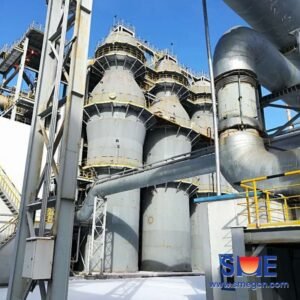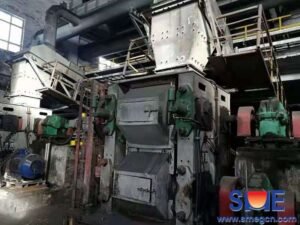Blast furnace ironmaking is a dominant process in the ironmaking industry, known for its mature technology and significant output advantages. More than 90% of the world’s iron is produced using blast furnace ironmaking. This process is divided into nine major systems based on their functions.
1.Raw material system
The primary task of the raw material system is to store, batch, sieve, and weigh various types of sinter, pellets, lump ore, and coke needed for blast furnace smelting, and then deliver these materials to the material truck and main conveyor belt.
The raw material system is mainly divided into two major parts: the ore tank and the coke tank. The ore tank stores a variety of ores, including sintered ore, lump ore, pellets, and flux. The number and size of the storage slots depend on the ratio of the various types of minerals and the required storage time. Generally, the storage time for sintered ore is not less than 10 hours, while the storage time for lump ore, pellets, and flux is relatively longer.
2. Feeding system
The role of the feeding system is to transport the raw materials and fuels stored in the ore and coke tanks to the top of the blast furnace charging equipment. There are two main methods for blast furnace charging: the inclined bridge material car and the belt conveyor.
The inclined bridge material car charging method is divided into single and double material car types. Single material car charging is suitable only for small blast furnaces and is gradually being phased out. New large and medium-sized blast furnaces mostly adopt the belt conveyor charging process.

3.Furnace top charging equipment
The role of the furnace top charging equipment is to distribute the charge materials within the blast furnace to appropriate locations according to furnace conditions. There are two types of furnace top charging equipment: bell-type and bell-less. Most small blast furnaces (below 750m3) use bell-type charging devices, while most large and medium-sized blast furnaces (above 750m3) use bell-less charging equipment.
4.BF system
The furnace system is the heart of the entire blast furnace ironmaking process. All other systems ultimately serve the furnace system. Nearly all the chemical reactions in blast furnace ironmaking occur within the furnace, and the performance of the furnace system directly determines the success of the entire ironmaking process. The service life of a blast furnace corresponds to the life of its furnace system.
In addition to the furnace itself, the furnace system includes the furnace shell, lining, cooling elements, cooling medium, external pipe network, and ancillary equipment such as the air outlet and air supply systems.
5.Gas system
The coarse gas system comprises an export pipe, rising pipe, falling pipe, discharge valve, dust collector, and a dust removal and humidifying device. The gas produced by the blast furnace contains a significant amount of dust, which must be removed for it to become purified gas suitable for use. Currently, there are two main types of dust collectors in the crude gas system: gravity dust collectors and cyclone dust collectors.
6.Tuyere platform and tapping system
The tuyere platform is designed to facilitate the changing of tuyeres, allow observation of furnace conditions, and enable maintenance activities. The tapping system handles the molten iron and slag produced by the blast furnace.
7. Slag treatment system
The slag treatment system’s role is to convert the liquid slag produced by the blast furnace into dry slag and water slag. Dry slag is generally used as construction aggregate, and some types have specialized uses. Water slag can be sold to cement factories as a raw material for cement production.
8.Hot blast stove
The hot blast stove is a crucial piece of equipment in blast furnace smelting, directly influencing the furnace’s work efficiency.

9.Coal powder preparation and injection system
The coal powder preparation process involves grinding coal into a fine powder and drying out the moisture. The dried coal powder is then transported to the blast furnace air outlet, where it is blown into the blast furnace to partially replace coke.




